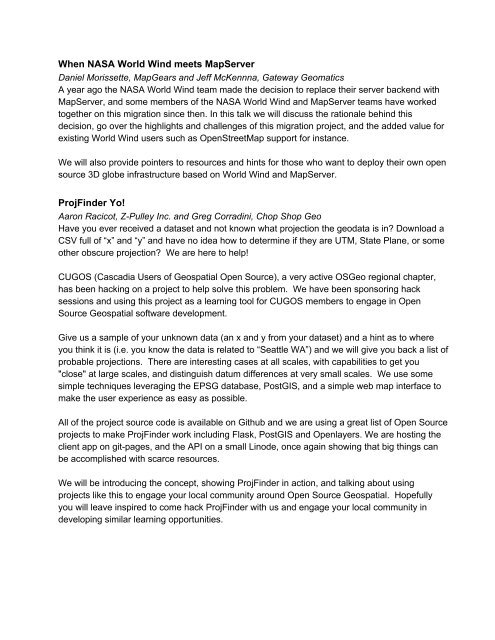FOSS4G North America Conference 2013 Preliminary Program
FOSS4G North America Conference 2013 Preliminary Program
FOSS4G North America Conference 2013 Preliminary Program
You also want an ePaper? Increase the reach of your titles
YUMPU automatically turns print PDFs into web optimized ePapers that Google loves.
When NASA World Wind meets MapServer<br />
Daniel Morissette, MapGears and Jeff McKennna, Gateway Geomatics<br />
A year ago the NASA World Wind team made the decision to replace their server backend with<br />
MapServer, and some members of the NASA World Wind and MapServer teams have worked<br />
together on this migration since then. In this talk we will discuss the rationale behind this<br />
decision, go over the highlights and challenges of this migration project, and the added value for<br />
existing World Wind users such as OpenStreetMap support for instance.<br />
We will also provide pointers to resources and hints for those who want to deploy their own open<br />
source 3D globe infrastructure based on World Wind and MapServer.<br />
ProjFinder Yo!<br />
Aaron Racicot, ZPulley Inc. and Greg Corradini, Chop Shop Geo<br />
Have you ever received a dataset and not known what projection the geodata is in? Download a<br />
CSV full of “x” and “y” and have no idea how to determine if they are UTM, State Plane, or some<br />
other obscure projection? We are here to help!<br />
CUGOS (Cascadia Users of Geospatial Open Source), a very active OSGeo regional chapter,<br />
has been hacking on a project to help solve this problem. We have been sponsoring hack<br />
sessions and using this project as a learning tool for CUGOS members to engage in Open<br />
Source Geospatial software development.<br />
Give us a sample of your unknown data (an x and y from your dataset) and a hint as to where<br />
you think it is (i.e. you know the data is related to “Seattle WA”) and we will give you back a list of<br />
probable projections. There are interesting cases at all scales, with capabilities to get you<br />
"close" at large scales, and distinguish datum differences at very small scales. We use some<br />
simple techniques leveraging the EPSG database, PostGIS, and a simple web map interface to<br />
make the user experience as easy as possible.<br />
All of the project source code is available on Github and we are using a great list of Open Source<br />
projects to make ProjFinder work including Flask, PostGIS and Openlayers. We are hosting the<br />
client app on gitpages, and the API on a small Linode, once again showing that big things can<br />
be accomplished with scarce resources.<br />
We will be introducing the concept, showing ProjFinder in action, and talking about using<br />
projects like this to engage your local community around Open Source Geospatial. Hopefully<br />
you will leave inspired to come hack ProjFinder with us and engage your local community in<br />
developing similar learning opportunities.


